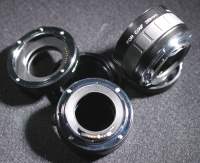
GALLERY |
| Home Page |
| Sub-Galleries |
| Aerial Views |
| Birds |
| Butterfllies / Moths |
| Critters |
| Don't Bug Me! |
| Giga-Gallery |
| Scenic - Activities - Etc |
| Wildflowers |
| Miscellaneous |
|
|
| Check It Out |
|
|
| Vintage Cigarette Lighters & Ashtrays |
| Frank Dutton World Travel Photos |
|
|
| Other |
| About Toledo-Bend Gallery & Equipment |
| Awards |
| LINKS |
| Thanks |
| Search |
| Translate |
|
|
Using Extension Tubes to Take Close-ups |
~ Click on any image for an enlargement - scrollable if it is too big for browser window ~ |
|
The following pictures show the effects of using extension tubes.The following equipment is used: Canon EOS 10D Camera, Canon EF 50mm f/1.8 lens, Kenko Extension Tube Set - 12mm, 20mm, 36mm. A dime was placed on black felt and continuous lighting was used for illumination. The pictures are taken with the camera handheld. The depth of field can get very shallow on these close up shots, especially with a stopped down lens, so it is very easy to get a portion of the image somewhat out of focus. None of the pictures are cropped - they are reproduced whole in order to illustrate more precisely how the image fills the picture with the various tubes and combinations in use. In all pictures the 50mm lens is used (indicated by "50mm") and extension tubes are added for "magnification" effect (indicated by "+??mm"). It does not matter which order the extension tubes are combined (e.g. 12+20 or 20+12 works the same). Theoretically, AutoFocus will work with extension tubes. As a practical matter, I found it works OK with the 12mm, but beyond that manual focus is a must. Along with increasing the focal length of the lens, the tube also allows the lens to focus closer to the subject than it otherwise would. Some of the pictures below are VERY close to the subject; theoretically, the lens used should focus as close as 18 inches; in practice I was less than 2" with some of the combinations below. NOTE: The Canon EOS 10D is a digital SLR camera. Since the chip which the light strikes is somewhat smaller than 35mm film would be, the effect "magnifies" the effective focal length of any lens used. In the case of the 10D the effect is 1.6x - so a 100mm lens becomes, effectively, a 160mm lens on this camera. Most digital SLRs have the same effect and generally are about 1.5x. Other than the "multiplier", the same enlargement effect holds true whether you are using film or digital, though. |
| 50mm only | 50mm + 12mm |
| 50mm + 20mm | 50mm + 32mm (12+20) |
| 50mm + 36mm | 50mm + 48mm (36+12) |
| 50mm + 56mm (36+20) | 50mm + 68mm (12+20+36) |


